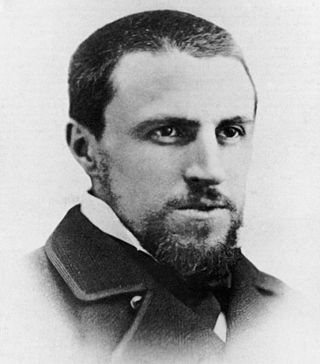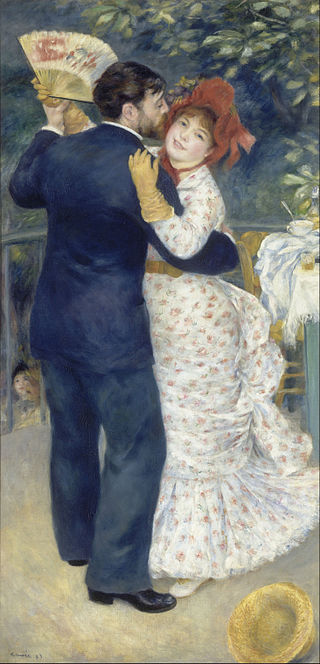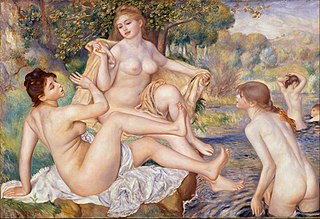
Impressionism was a 19th-century art movement characterized by relatively small, thin, yet visible brush strokes, open composition, emphasis on accurate depiction of light in its changing qualities, ordinary subject matter, unusual visual angles, and inclusion of movement as a crucial element of human perception and experience. Impressionism originated with a group of Paris-based artists whose independent exhibitions brought them to prominence during the 1870s and 1880s.

Pierre-Auguste Renoir was a French artist who was a leading painter in the development of the Impressionist style. As a celebrator of beauty and especially feminine sensuality, it has been said that "Renoir is the final representative of a tradition which runs directly from Rubens to Watteau."

Gustave Caillebotte was a French painter who was a member and patron of the Impressionists, although he painted in a more realistic manner than many others in the group. Caillebotte was known for his early interest in photography as an art form.

Bal du moulin de la Galette is an 1876 painting by French artist Pierre-Auguste Renoir.

Luncheon of the Boating Party French: Le Déjeuner des canotiers is an 1881 painting by French impressionist Pierre-Auguste Renoir. Included in the Salon in 1882, it was identified as the best painting in the show by three critics. It was purchased from the artist by the dealer-patron Paul Durand-Ruel and bought in 1923 from his son by industrialist Duncan Phillips, who spent a decade in pursuit of the work. It is now in The Phillips Collection in Washington, D.C. It shows a richness of form, a fluidity of brush stroke, and a flickering light.

By the Seashore is a painting by Pierre-Auguste Renoir completed in 1883 and is now housed in the Metropolitan Museum of Art in New York City.

Bain à la Grenouillère is an 1869 painting by the French impressionist painter, Claude Monet.. It depicts "Flowerpot Island", also known as the Camembert, and the gangplank to La Grenouillère, a floating restaurant and boat-hire on the Seine at Croissy-sur-Seine. He was accompanied by Pierre-Auguste Renoir, who also painted the scene at the same time.

Dance in the Country is an 1883 oil painting by French artist Pierre-Auguste Renoir. It is currently kept at the Musée d'Orsay in Paris.

Boulevard Montmartre, Mardi Gras by Camille Pissarro currently resides in the permanent exhibition at the Armand Hammer Museum in Los Angeles, California. This work is part of a series of fourteen paintings depicting different times of the day and seasons of the Boulevard Montmartre in Paris. Camille Pissarro is known as the "Father of Impression" for his "teacher's eye" of drawing what he saw in front of him.

Young Girls at the Piano is an oil-on-canvas painting by French artist Pierre-Auguste Renoir, a leading painter in the development of the Impressionist style. The painting represents his late work period (1892–1919). It was completed in 1892 as an informal commission for the Musée du Luxembourg. Renoir painted three other variations of this composition in oil and two sketches, one in oil and one in pastel. Known by the artist as repetitions, they were executed to fulfill commissions from dealers and collectors. The work is on public display at the Musée d'Orsay in Paris, Metropolitan Museum of Art in New York, and the Musée de l'Orangerie in Paris.

Dance at Bougival is an 1883 oil-on-canvas painting by the French artist Pierre-Auguste Renoir, currently in the collection of the Museum of Fine Arts in Boston, Massachusetts, United States. Described as "one of the museum's most beloved works", it is one of three in a collection commissioned by Paul Durand-Ruel. It depicts a scene in the French village of Bougival, about 15 km from the center of Paris, a site utilized by many Impressionists besides Renoir including Claude Monet, Alfred Sisley, and Berthe Morisot.

Lise Tréhot was a French art model who posed for artist Pierre-Auguste Renoir from 1866 until 1872, during his early Salon period. She appeared in more than twenty paintings, including notable works such as Lise with a Parasol (1867) and In Summer (1868), and she was the model for almost all of Renoir's work featuring female figures at this time. Tréhot married Georges Brière de l'Isle in 1883 and raised four children to whom she bequeathed two of Renoir's paintings, Lise Sewing (1867–68) and Lise in a White Shawl (1872), both of which are currently held by the Dallas Museum of Art.

Lise with a Parasol is an oil on canvas painting by French artist Pierre-Auguste Renoir, created in 1867 during his early Salon period. The full-length painting depicts model Lise Tréhot posing in a forest. She wears a white muslin dress and holds a black lace parasol to shade her from the sunlight, which filters down through the leaves, contrasting her face in the shadow and her body in the light, highlighting her dress rather than her face. After having several paintings rejected by the Salon, Renoir's Lise with a Parasol was finally accepted and exhibited in May 1868.

Les Grandes Baigneuses, or The Large Bathers, is a painting by Pierre-Auguste Renoir made between 1884 and 1887. The painting is in the Philadelphia Museum of Art, in Philadelphia.

Aline Victorine Charigot was a model for Auguste Renoir and later became his wife while continuing to model for him and then caring for him when he became disabled. She is pictured in many of his paintings over very many years, most famously in the early 1880s Luncheon of the Boating Party, and Blonde Bather. They had three children together, two of whom, Pierre and Jean, went on to have distinguished careers in film, and the third, Claude, became a ceramic artist. Pierre had a son Claude who became the well-known cinematographer. She predeceased her elderly husband.

Victor Chocquet was a French art collector and an ardent propagandist of Impressionism. As a senior editor at the Directorate-General of Customs and Indirect Taxes, he was present at all the exhibitions where he defended painters confronted with mockery and insults. His collection was huge. It was dispersed after his death in 1899. Many of the paintings are currently in American museums.

Diana is a painting from 1867 by the French painter Pierre-Auguste Renoir. It is thought to depict the painter's lover Lise Tréhot as the Roman goddess Diana, although the exact identification of the model in the painting is disputed by art historians.

A Couple also known as The Engaged Couple or Alfred Sisley and his Wife, is an oil-on-canvas painting by the French artist Pierre-Auguste Renoir (1841–1919), created around 1868 during his early Salon period at a time when he focused on thematic works about couples. It was acquired by the Wallraf–Richartz Museum in 1912.

Léonard Renoir, The Artist's Father is an oil on canvas painting by the French artist Pierre-Auguste Renoir (1841–1919), created in the summer of 1869 at the age of 28. The painting depicts Renoir's father, a tailor, at 70 years old. Due to financial difficulties, Renoir was living with his parents at the time. The Realist conventions are evident, with the portrait showing the influence of Édouard Manet (1832–1883), using a limited palette of black and white to portray Renoir's father's stern demeanor, giving it a "somber and austere" effect. It was painted just before he joined Claude Monet (1840–1926) to work on the Seine at Croissy-sur-Seine.



















